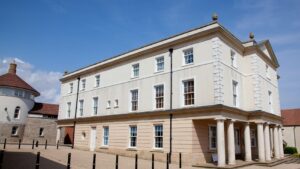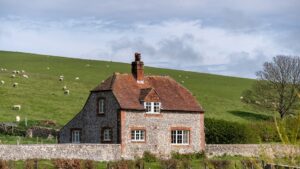Future building

Report calls for tax and planning reforms to support sustainable development
London, 17th January 2024 – Patient community development schemes that focus on adding value over generations rather than chasing quick sales and returns deliver greater rewards for investors, developers and the local population alike, according to a new report out today from leading UK law firm Farrer & Co and architect and masterplanner ADAM Architecture.
Authored and researched by Future Places Studio, “Placemaking Two: A stewardship approach to creating communities“, a follow up to “Placemaking: a patient approach to creating communities” published in early 2020, identifies best practice examples of modern developments and delves into how these projects have successfully delivered both financial returns and community benefits.
With the country aiming to build 300,000 new homes per year, the report picks out innovative schemes that have the potential to be replicated more widely and identifies 8 factors common to successful approaches to sustainable development:
- Taking a long-term view at the outset of a project
- Accepting a deferred return on investment, which can lead to greater long-term revenues
- Measuring the success through a social and environmental lens – not just in terms of a return on capital or profit
- Prioritising the design and community building of a scheme through a long-term masterplan and design codes
- Placing greater emphasis on community and local authority co-creation
- Re-thinking the business-as-usual approach to social housing, streets, mixed-use, green spaces and social infrastructure
- Putting in place a stewardship model to maintain the ongoing quality of the place
- Prioritising community health, wellbeing and social cohesion through best practice design solutions
The report also explores how, where there are shared objectives, such as delivering affordable homes or key community infrastructure, private-public joint ventures can de-risk projects for landowners and developers while allowing local authorities to gain a share of the profits. These ventures can also open up the market to a broader range of developers, resulting in more choice of housing and more diversified local economies that better address the new living and working preferences that have emerged post-Covid. Crucially, in many instances, it becomes more profitable for developers not to sell upfront, but instead to enjoy longer term rewards that also benefit local communities.
At the same time, the report highlights how current tax and planning regimes are hampering progress on sustainable development, being instead biased in favour of cheap and fast developments that prioritise maximising value at point of sale over building resilient and convivial places.
Mark Gauguier, Head of Commercial Real Estate, Farrer & Co, said: “The current planning application process for large development sites is complex, strenuous, and expensive. The system adds unnecessary risk and uncertainty, hindering patient development by many smaller players and landowners with stewardship ambitions.
“Despite this policy backdrop, our report has captured inspiring examples of local authorities, landowners, investors and the local population coming together to re-imagine mixed-use places geared towards the evolving aspirations of specific communities. We need a more streamlined approach to planning and to level the tax playing field if we are to encourage more landowners to act as custodians of a place, more local authorities to co-invest in these projects and more local people to engage positively with the process. Patient capital investment has huge potential to help ease the pressure on housing stock and to ensure that more communities can enjoy desirable, sustainable, and people-oriented places for generations to come.”
Hugh Petter, Director, ADAM Architecture, says: “What we are doing is drawing from some of the best current examples, and those from the recent past that challenge the status quo. In the patient development model, quality of place and life are at the forefront, and the increased time-horizon allows the landowner to follow best practice and invest for the benefit of the wider community and the place as a whole.
But this report also recognises that, to help encourage this more enlightened approach, we need changes in terms of tax and incentives, finance, and planning. Without these the current default system of up-front land sale to a developer will continue to be favoured where, regrettably, short term numbers are all important, and the quality of life; the quality of place, and the ability for residents to live a low carbon lifestyle are not even properly considered.”
Contributors to the report include the King’s Foundation, the Duchy of Cornwall, Knight Frank, Savills, Smart Growth Associates, and Stockbridge Land and Red Tree.
ENDS
For further information, please contact:
Clo Davey, Farrer Kane & Co: clo@farrerkane.com; 07795 203 181
Ines Alves, Farrer Kane & Co: inesalves@farrerkane.com; 07788 926 243
About Farrer & Co
Farrer & Co is a leading independent law firm based in London, first founded in 1701. The firm, noted for its technical excellence and client service, provides seamless support to families, businesses, financial services, education and not-for-profit organisations across all aspects of the law, wherever the need arises. From property, trusts and philanthropy to M&A, insolvency and reputation management, the firm prides itself on its client-centricity and the values which underpin that.
Farrer & Co and ADAM Architecture first launched “Placemaking – a patient approach to creating to communities” in February 2020 [see here]. “Placemaking Two: A stewardship approach to creating communities” can be found here.
For further information please visit www.farrer.co.uk.
About ADAM Architecture
ADAM Architecture is run by Directors Nigel Anderson, Hugh Petter, George Saumarez Smith, Robbie Kerr, Darren Price and Robert Cox and is the leading practice specialising in Classical and Traditional architecture, and contextual urban design. With offices in Winchester and London and over 130 staff the practice is recognised worldwide for its award-winning projects, which range from new country houses and the restoration of historic buildings, commercial and public buildings, to masterplans including village extensions and major housing developments.
ADAM Architecture’s Directors are consulted by government agencies and ministries on policy and design, and several urbanism projects have been cited as exemplar examples in recent government publications. They are trustees of national interest groups and prominent in professional affairs and are active members or trustees of many national and international architectural and urban design organisations.

